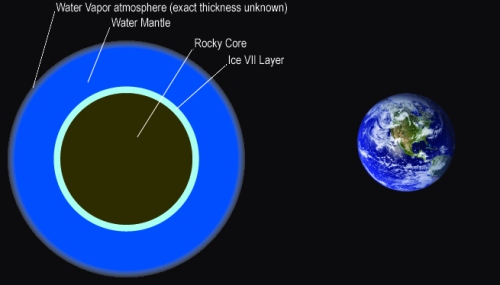A few days ago, it was announced that the star GJ 1214 has a planet orbiting it, dubbed GJ 1214b. The massively interestesting part is they were able to measure this planet’s diameter as it transited across its star, and measure its mass via its star’s wobble like you do. Anyway, using this they calculated the planet’s density, which is estimated to be around only 1800 kg/m^3.
For comparison, Earth is around 5500 kg/m^3, while water is about 1000 kg/m^3. In other words this planet is mostly made of liquid water! At least that’s the most likely answer. The next most likely liquids (like liquid carbon dioxide) boil at a much lower temperature than what the planet is estimated be at (between 250 – 550 degrees F).
Now, the more astute among may notice that the planet is also above the boiling point of water. The thing is, as pressure goes up, so does the boiling point (the reverse is also true, which is why at higher elevations the boiling point drops and it take longer to cook food). For example, at 100 atmospheres, the boiling point of water is around 520 degrees F. So it’s possible for there to be a huge global ocean, as long as a sufficiently dense atmosphere is also there. That sounds like a pretty big conjecture, but the density of the planet is known, meaning there must be some sort of atmosphere dense enough to hold it in. My bet is that its mostly water vapor (most astronomers are saying its likely hydrogen and helium, but at the same time there’s substantial loss to space due to its proximity to the star, and there’s really no way for the planet to make more hydrogen and helium to replenish it).
So, lets explore this world together! First, based on its density, scientists calculate that it composed of roughly 25% rock and 75% water. Obviously, the rock will be in the core since rock is denser than water and will sink towards the center. The planet’s diameter is estimated to be 34,000 km across, so its core, taking up about one-fourth the volume, would be around 21,000 kilomteters across. On top of that is water, an ocean 6500 km deep. That’s roughly 1000 times as deep as Earth’s oceans!
Now some interesting things happen when you consider how that all fits together. As I said before the atmosphere is likely composed of water vapor. Water vapor is a greenhouse gas, and will cause the temperature to rise, causing more water to evaporate, thus increasing the greenhouse effect. This will likely continue until some sort of equilibrium is reached, where the influx of heat from the star is the same as the amount radiated away. This might be beyond the point where water goes supercritical (that is, the line between liquid and gas vanishes and they sort ‘blend into’ each other). That means that the water vapor atmosphere likely just gets denser and denser until it reaches the density of water, at which point it can’t compress anymore.
Even more interesting is what happens down in the depths of this massive ocean. There, the pressure become high enough that the water will become solid, making an exotic form of ice known as Ice VII. This is not like ordinary ice. This is hot ice, denser than water, and probably forms a layer around the rocky core.
In short, this planet most likely looks like a miniature Jovian planet, with water as the gas present instead of hydrogen.
So what about the most obvious question: if there water, what about life? I don’t know. With supercritical water I don’t think that organic structures could even form. But, if the atmosphere really is made of hydrogen (which isn’t a greehouse gas) the temperature would stay much lower, low enough for water to retain all its life-assisting properties. Anyway, here’s a nice graphic (I like graphics) to help illustrate what this planet is like:

